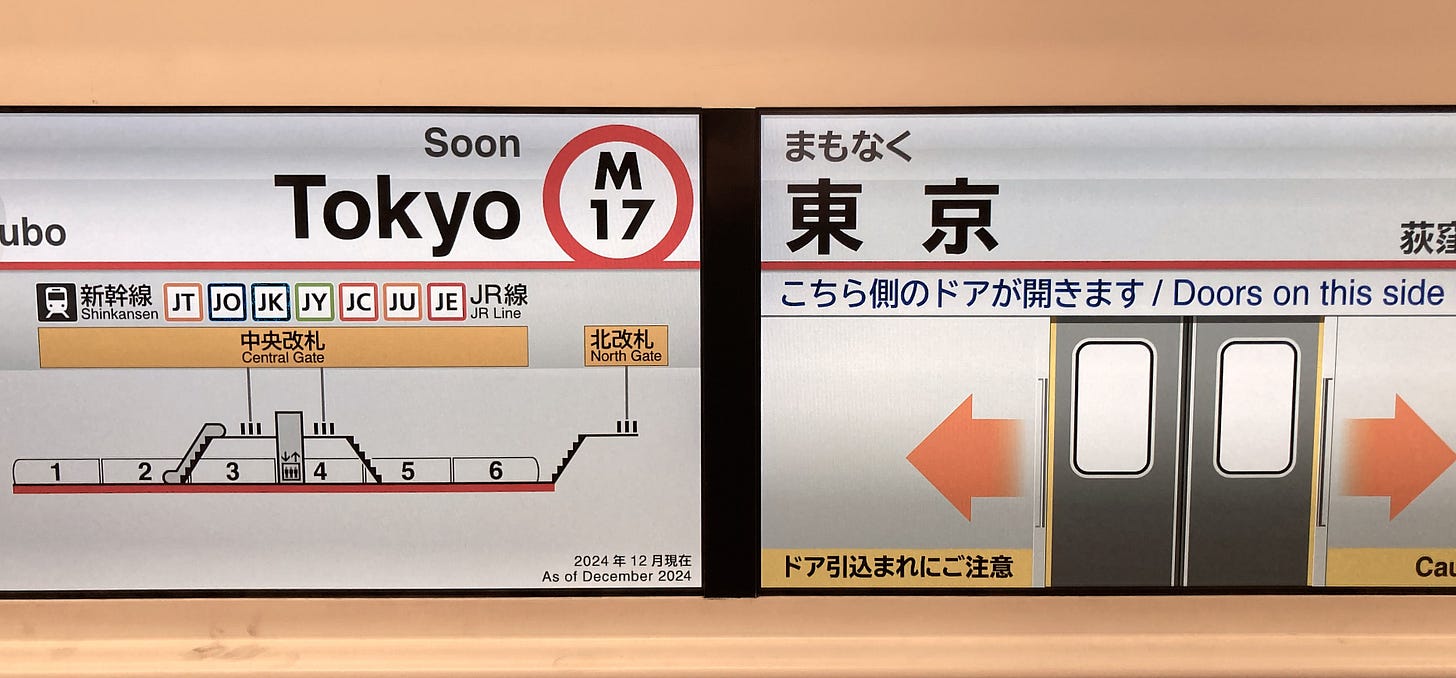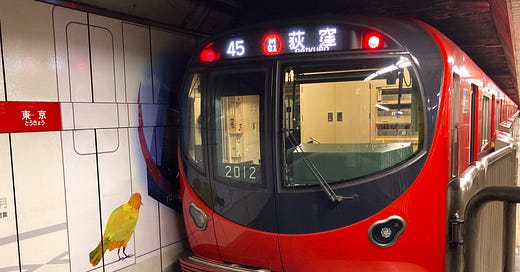#140 Marunouchi Line
Maximizing the coverage of the Tokyo subway, adding the Marunouchi Line to the Ginza Line.
A powerful cold wave is said to hit Japan this week, but looking further ahead, we are only about a month away from the cherry blossoms. At this time of year, the primary concern of visitors to Japan is where to see the cherry blossoms in full bloom. Unfortunately, at this point, there are still too many variables to predict accurately.
In such a situation, many people would like to go sightseeing alone, without relying on a guide. This week's Japan A to Z is the second installment in my series on the Marunouchi Line for those who wish to walk around freely on their own. The second oldest subway in Tokyo after the Ginza Line, the Marunouchi Line, runs through the Marunouchi district of Tokyo Station, connecting Ikebukuro and Ogikubo in the part of the west of Tokyo. By understanding the Marunouchi Line and using it with the Ginza Line, which I mentioned to our paying members last month, you can cover most of the major sightseeing spots in Tokyo. This post will hint that everyone can walk around Tokyo sightseeing more quickly and efficiently. And I hope this post will give you some idea about my paid posts.
Outline of Marunouchi Line
The Marunouchi Line opened in January 1954. It was the second subway line to open in Tokyo after the Ginza Line and the fourth in Japan. This Marunouchi Line consists of a mainline connecting Ikebukuro to Ogikubo and a branch line connecting Nakanosakaue to Honancho, totaling 27.4 km. The 1950s coincided with the period of postwar reconstruction Japan experienced, and the western terminus was Ogikubo, as the part of the west of Tokyo was then undergoing an explosion of residential development and an urgent need to improve transportation capacity.
Stations to Check
The central government office area from Tokyo to Akasaka-mitsuke and Shinjuku are the stations to check on the Marunouchi Line. The following is a station-by-station breakdown.
M1: Ogikubo:
Ogikubo is the first station on the west side of the line and is still a vital transfer station for commuters using the Chuo Line. From here, commuters can go to Kasumigaseki and other central government office areas without changing trains—Suginami-ku, where Ogikubo is an extremely popular quiet residential area.
M7: Nishi-Shinjuku:
A new station that did not exist at the time of its opening, it provides easy access to hotels such as Hilton Tokyo and Hyatt Regency Tokyo.
M8: Shinjuku:
JR lines dominate Shinjuku Station, and changing trains from JR requires a short walk. However, it should always be an option because of its good access to the city center.
M9: Shinjuku 3-chome:
Although adjacent to Shinjuku in terms of distance, this area offers easy access to Shinjuku Gyoen and Kabukicho. In addition, be sure to check out the food court in the basement of Isetan, a long-established department store. It is open until 8 p.m., so those staying at hotels in the area should check it out.
M13: Akasaka-mitsuke:
This station is significant as a transfer station for the Ginza Line. Check out the Ginza and Marunouchi Lines stations, focusing on transfers at Akasaka-mitsuke Station. The image of the lines is greatly simplified.
M16: Ginza:
The Marunouchi Line station is near the Sukiyabashi intersection, one street west of Ginza St. If you are going to the center of Ginza from the Shinjuku area, transferring to the Ginza Line at Akasaka-mitsuke, as mentioned above, is more convenient.
M17: Tokyo:
The subway station is located in the basement of the red-brick Marunouchi Exit, and the JR Chuo Line is a much more convenient way to transfer to the Shinkansen from Shinjuku. On the other hand, if you want to take the Narita Express to Narita Airport, the subway is convenient since the underground station is adjacent to the subway station.
M25: Ikebukuro:
Although not as popular as Shibuya and Shinjuku among the subcenters, the area has become a new mecca for anime fans in recent years and should be considered by fans.

Effective use of the Marunouchi Line
The following summarizes the Marunouchi Line's practical uses and convenient cases.
Transfer at Akasaka-mitsuke on the Ginza Line to go to Shinjuku Gyoen or Shinjuku.
Shinjuku 3-chome station: Hotels in Kabukicho, Department store Isetan Food Court
Shinjuku: Access to Keio Plaza Hotel
Nishi-Shinjuku: Access to Hilton Tokyo and Hyatt Regency Tokyo
Access to Airports
Narita Airport:
Narita Express has good access to JR Tokyo Station. The Marunouchi Exit reduces the distance to travel by Marunouchi Line.
Haneda Airport:
It is inconvenient because there is no direct access to Shinagawa Station or Hamamatsucho.
Finally
Regardless of Narita or Haneda, the Marunouchi Line should not be considered the main axis. I recommend the Ginza Line as a base when considering sightseeing routes.
Using the Ginza Line as a base and adding the Marunouchi Line, you can cover the Ikebukuro, Shinjuku, and Shibuya sub-centers. In addition, the Akasaka-mitsuke station, where transfers can be completed on the opposite side of the platform or by changing one floor, should be used.
In extreme cases, Tokyo sightseeing is best done with a 72-hour Tokyo Subway ticket (1,500 yen) and a Suica IC card. You will use mainly the Ginza Line and, if necessary, the Marunouchi Line. This combination is almost a complete tour with a few exceptions, such as the Meiji Shrine and Tsukiji.
The Tokyo subway system is complex even for residents, and I do not have all the stations in my head. Some stations require prior confirmation of the flow lines at transfer stations. You should master only the main lines and add and update them as needed.
Some of you may have tried your best to memorize the lines, but you may have fallen behind halfway through and ended up looking for a guide. If you are not confident, please arrange a guide for 4 hours and ask that guide to teach you the concept of public transportation in Tokyo. As a guide in Tokyo, I find it most important to visit about two sightseeing spots in four hours and give clients compact introductory information on the concept of subways, how to get around, restaurants near hotels, and food supply information. If you are considering such an approach to Tokyo sightseeing, I would be happy to help you.
Note: Please take a look at the previous articles for 3 important tips about Tokyo's subway system.









I still don’t have a visit to Japan on my calendar (Irish archaeology with a friend as guide an out this year!) but thank you very much for these online excursions!
Nice. I remember Seoul government created a guidebook years ago featuring different lines of metro and stations along with their features. Hope will see one from Tokyo gov’t one day with you pioneering it already. Oimachi is another interesting line in my opinion.